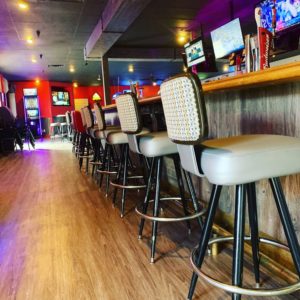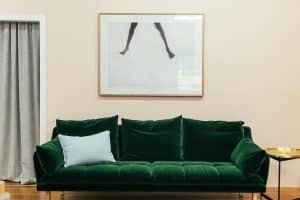


Reupholstery Furniture: What Is It? + 3 Examples

This guide lists 30 common upholstery tools that the pros use. Its purpose is to offer clarity on what tools matter most in this line of work.
A Quick Note About Professional Upholstery Tools
Before we get started with the list, it’s worth noting that there is no one-size-fits-all set of upholstery tools. Different pros use different tools depending on the setup they have, be it a small home studio or a full-scale commercial shop.
Some tools also serve multiple purposes, and many professionals develop their own preferences over time for how they want to use them. No two upholsterers will agree on the perfect toolkit, but in general, the more types of projects the upholsterer takes on, the more tools they’ll need.
The list below reflects what you’d typically find in a heavy-duty upholstery shop that handles large-scale professional work.
Let’s take a look!
An industrial sewing machine is essential for serious upholstery work. The machine should preferably have a walking foot with a large gap between the presser foot and needle plate to help feed thick materials through it.
Additionally, the sewing machine should (and will likely) have a reverse lever that lets the upholster back stitch, as well as a welt foot that makes sewing welt cord much easier. A knee lift is also often found in sewing machines used in professional shops.
The tack hammer is a go-to tool in upholstery. Professional upholsterers use it to drive in tacks and handle various other tasks that call for a delicate touch.
Most tack hammers are lightweight and have a small dual head, and one side is usually magnetic.
In upholstery, a mallet is a must-have for jobs that require force but also need some delicacy. Unlike a standard hammer, which can damage wood and fabric, a mallet delivers a soft, controlled strike. White rubber mallets are a common choice because they won’t mar finished wood or painted surfaces.
Mallets come in a variety of materials, such as rubber, rawhide, nylon, and polymer, each of which offers a different level of firmness. Some mallets have interchangeable heads to improve their versatility.
Hard tape measures are great for getting straight, edge-to-edge measurements, which are essential in upholstery.
Soft tape measures, meanwhile, are ideal when you need to wrap around curves, arms, or rounded edges.
Precision matters in upholstery, and that starts with accurate measuring.
Obviously, a good ruler helps mark straight lines. Measuring squares, meanwhile, are just as essential, as they’re used to check and maintain right angles.
Without these basic tools, even small measuring errors can throw off an entire upholstery project.
Wire cutters are often used to pull out stubborn staples, usually after loosening them with a tack puller or staple lifter. A slightly dull pair of wire cutters is actually preferred because it grips the staple without slicing through it.
Beyond staples, wire cutters can trim upholstery wires, snip metal tack strips, or clip zip ties. Overall, they’re very useful.
Hog-ring pliers are used to attach fabric to seat frames using metal hog rings. You see hog rings most often in automotive seats, where a secure hold is critical.
The pliers themselves are designed with grooves so that upholsterers can grip the rings easily and then squeeze and crimp them shut.
A snap tool is designed to install snap fasteners. The basic version of the tool includes a handheld punch and a small base that holds the snap parts in place. When pressure is applied, the tool crimps the snap pieces together securely.
There are different styles, from simple manual sets to advanced tools like the Pres-N-Snap, the latter of which streamlines the process with one-handed operation and interchangeable dies.
A sharp knife is a must-have in upholstery. There are several types that can work well for the job, be it a craft knife, utility knife, or box cutter. Some upholsterers even keep a pocket knife available.
Most professionals like to have a few different knives on hand. The most important thing is having a blade that’s sharp enough to make clean cuts.
Scissors are frequently used in upholstery, and having a few different kinds is very helpful.
Heavy-duty fabric scissors are ideal for cutting through thick materials. Lightweight scissors are better suited for cutting threads. And then you have scissors for cutting through foam, vinyl, etc.
The regulator, also sometimes called a sharp point, is one of the more versatile tools in upholstery, thanks to its pointed end.
It’s perfect for the kinds of tasks that upholstery demands, such as removing staples.
Upholstery involves a lot of cutting, so keeping your blades sharp is a must. For this reason, you’ll find sharpeners in practically every professional upholstery shop.
Staple guns are a staple of upholstery—pun intended.
All jokes aside, a pneumatic staple gun is far more efficient than a manual stapler and saves the hands from fatigue during long projects.
While pneumatic staple guns are a must for professional upholstery, that doesn’t mean handheld staplers are any less important.
In fact, a high-quality plier-style stapler is a key part of a well-rounded tool kit.
Generally, glue guns show up in two forms in upholstery, and both have their uses. First, there’s the standard hot glue gun.
Then there’s what some upholsterers refer to as a “spray glue gun.” While not a glue gun in the traditional hot-melt sense, this tool has a cylinder filled with contact adhesive.
Mineral spirits are used to clean up tools after upholstery work, whether it’s contact cement on a spray gun nozzle or glue buildup on scissors and scrapers.
A blower is useful for clearing dust, bits of foam, and other debris from furniture.
Professional upholsterers use steamers for various tasks, such as restoring foam and softening materials during installation.
You’ll likely find steamers in most upholstery shops thanks to their ability to make materials easier to work with.
An iron is useful for smoothing out wrinkles and creases in upholstery fabric. That said, not all fabrics can handle direct heat, so an iron has to be used carefully and only when appropriate.
Upholstery pins are used to temporarily hold fabric in place. There are various types of pins, including straight pins, T-pins, and twist pins. Each has a unique use.
For example, twist pins are often used to hold slipcovers or armrest covers in place without damaging the fabric.
Curved needles come in various sizes and are used for hand-stitching. They’re ideal for fixing tears along curves and edges and reaching into tight or awkward spots.
A button needle, also known as a tufting needle, is designed to attach buttons and create tufting. If you’re doing any type of button work, this tool is a must.
An impact driver delivers more torque than a standard drill. If you’re assembling frames or reinforcing furniture, this tool is quite helpful.
An electric drill is a common tool in upholstery shops and is often used for frame repairs. Every upholsterer should have one handy.
Sanding is a big part of upholstery, and a table top sander makes the job a lot faster and easier.
Clamps are used to hold things in place, and most upholsterers keep a few different types within reach. Some different types of clamps upholsterers use include C-clamps, bar clamps, and spring clamps.
A webbing stretcher is used to tighten and replace worn-out webbing in furniture. It’s especially useful on older pieces where the original webbing has sagged or deteriorated.
A pop rivet tool is used to fasten materials together when the upholsterer can’t access both sides. It comes in handy and is commonly found in upholstery shops.
Ok, to be fair, this isn’t just one tool, but a variety of saws.
Foam saw, table saw, chop saw, band saw—these are all very important for upholstery work.
Some might consider threads to be a supply rather than a tool. With that caveat in mind, there are a variety of threads that service upholstery needs.
However, you generally want upholstery thread, which is typically thicker and of better quality than basic sewing threads.
The upholstery tools that the pros use can vary from shop to shop, but these 30 represent the ones you’ll find in most professional setups.
We use high-quality tools to ensure every project result is satisfactory. If you’re looking for expert upholstery work that treats your furniture with care and respect, contact Redesign Upholstery.
We’re located in the Las Vegas area and have worked with clients ranging from local families to celebrities to big names like Cirque Du Soleil.


